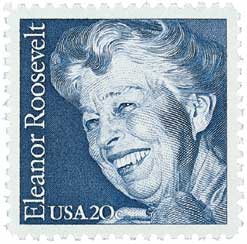
# 3185d - 1998 32c Celebrate the Century - 1930s: Eleanor Roosevelt
32¢ Eleanor Roosevelt
Celebrate the Century – 1930s
City: Cleveland, OH
Quantity: 12,533,000
Printed By: Ashton–Potter (USA) Ltd
Printing Method: Lithographed, engraved
Perforations: 11.5
Color: Multicolored
Happy Birthday Eleanor Roosevelt
At an early age, Roosevelt chose to be addressed by her middle name. Even as a child, Roosevelt was mature and acted in an old-fashioned manner, leading her mother to nickname her “Granny.” Though born into a very wealthy family, Roosevelt lost both her parents when she was young and would suffer depression for the rest of her life.
Roosevelt had private tutoring until she was 15, at which point she went to the Allenswood Academy in England. Her feminist headmistress would have a lasting impact on her. By the time Roosevelt left the school in 1902, she could speak fluent French and was one of the most popular students there. She then returned to America for her debutante ball (a “coming of age” party for wealthy young women) and joined the New York Junior League, where she taught dance and calisthenics.
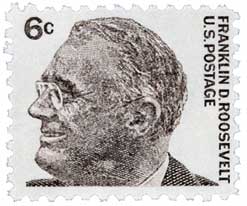
During the summer of 1902, Roosevelt ran into her father’s fifth cousin, Franklin Delano Roosevelt, on a train to Tivoli, New York. They soon began a secret relationship and were engaged on November 22, 1903. Franklin’s mother strongly opposed the relationship and tried several times to split them up. Despite his mother’s protests, they were married on March 17, 1905. President Theodore Roosevelt, Eleanor’s uncle, gave her away. The couple lived in New York but Eleanor found Franklin’s mother to be overly controlling.
When Franklin was stricken with polio in 1921, Eleanor convinced him to remain in politics, while his mother wanted him to retire and become a country gentleman. Eleanor made public appearances on his behalf and used her contacts to further his career. At the same time, she joined the Women’s Trade Union League and helped raise funds for their goals, which included a 48-hour workweek, minimum wage, and abolishment of child labor.
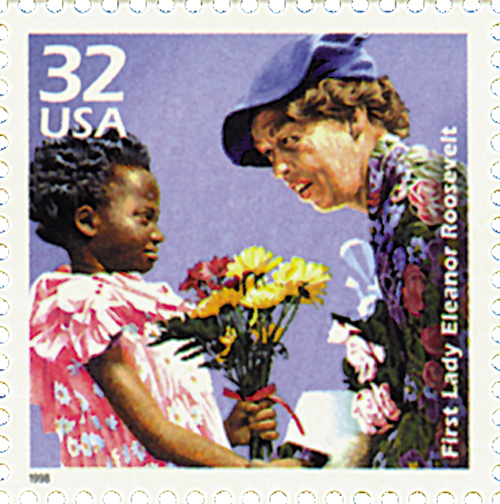
When Franklin was elected President in 1932, Eleanor became depressed. She knew that previous First Ladies were largely concerned with hostess and domestic affairs, neither of which interested her. She made it her mission to redefine the role of First Lady. Eleanor continued her busy speaking schedule and was the first First Lady to hold a press conference. She would hold 348 while in the White House and banned male reporters, forcing newspapers to hire female reporters. She also wrote a newspaper column, “My Day,” which was another first. The column ran six days a week from 1936 until her death in 1962 and included her daily work as well as humanitarian issues.
One of the projects dearest to Eleanor was Arthurdale, a community in West Virginia. In 1933, she visited homeless miners in Morgantown, West Virginia. She proposed building a new community where they could make their living with subsistence farming, handicrafts, and a manufacturing plant. Eleanor saw the town as a model for “a new kind of community” where workers could live better. While the project was largely considered a failure, Eleanor believed it was a success, as the residents had become self-sufficient.
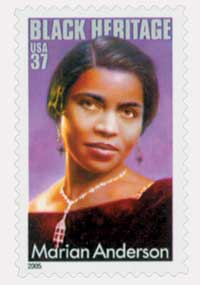
Another issue of great importance to Eleanor was civil rights. She frequently spoke out for the rights of African Americans, even challenging her husband’s New Deal policies because they did not equally benefit all races. In 1939, she stood up for African American singer Marian Anderson, who was denied the use of Constitution Hall by the Daughters of the American Revolution. Eleanor left her position with the group and arranged for Anderson to sing at the Lincoln Memorial. While she was very popular with African Americans, her firm stance made her unpopular in the South. This was one of many factors that led to her being considered the most controversial U.S. First Lady.
When World War II broke out, Eleanor encouraged her husband to allow European refugee children to immigrate to America. She hoped he would allow more immigration for those persecuted by the Nazis, but Franklin did the opposite. According to her son, Eleanor’s deepest regret was that she was not able to get Franklin to accept more refugees during the war.
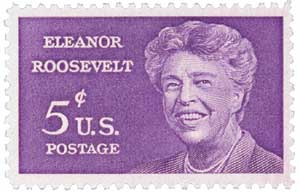
Eleanor co-chaired the Office of Civilian Defense (OCD), which gave volunteers more responsibility in war preparation. She also pushed for women and African Americans to take a larger role in the war effort, particularly giving women factory jobs a year before it became common practice. Eleanor also gave her support to the Tuskegee Airmen, flying with one of their pilots and bringing national attention to their training program. Also during the war, Eleanor took two trips overseas to visit troops. Her visit to the South Pacific was particularly morale boosting.
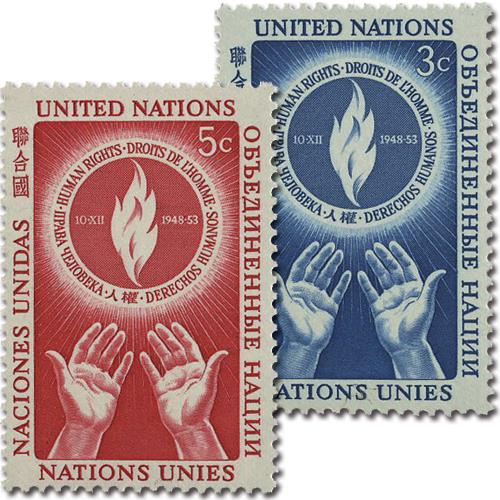
After Franklin died in April 1945, Eleanor left the White House and moved to New York. Later that year, she was appointed a delegate to the United Nations General Assembly. The following year she became the first chairperson of the U.N. Commission on Human Rights and later helped draft its Universal Declaration of Human Rights. Over the years she refused several offers to run for political offices. She averaged 150 national and international speaking tours per year and received 35 honorary degrees.
Eleanor died on November 7, 1962. At her memorial service, Adlai Stevenson asked, “What other single human being has touched and transformed the existence of so many?”
Click here to see Eleanor Roosevelt’s speech on Human Rights.
32¢ Eleanor Roosevelt
Celebrate the Century – 1930s
City: Cleveland, OH
Quantity: 12,533,000
Printed By: Ashton–Potter (USA) Ltd
Printing Method: Lithographed, engraved
Perforations: 11.5
Color: Multicolored
Happy Birthday Eleanor Roosevelt
At an early age, Roosevelt chose to be addressed by her middle name. Even as a child, Roosevelt was mature and acted in an old-fashioned manner, leading her mother to nickname her “Granny.” Though born into a very wealthy family, Roosevelt lost both her parents when she was young and would suffer depression for the rest of her life.
Roosevelt had private tutoring until she was 15, at which point she went to the Allenswood Academy in England. Her feminist headmistress would have a lasting impact on her. By the time Roosevelt left the school in 1902, she could speak fluent French and was one of the most popular students there. She then returned to America for her debutante ball (a “coming of age” party for wealthy young women) and joined the New York Junior League, where she taught dance and calisthenics.

During the summer of 1902, Roosevelt ran into her father’s fifth cousin, Franklin Delano Roosevelt, on a train to Tivoli, New York. They soon began a secret relationship and were engaged on November 22, 1903. Franklin’s mother strongly opposed the relationship and tried several times to split them up. Despite his mother’s protests, they were married on March 17, 1905. President Theodore Roosevelt, Eleanor’s uncle, gave her away. The couple lived in New York but Eleanor found Franklin’s mother to be overly controlling.
When Franklin was stricken with polio in 1921, Eleanor convinced him to remain in politics, while his mother wanted him to retire and become a country gentleman. Eleanor made public appearances on his behalf and used her contacts to further his career. At the same time, she joined the Women’s Trade Union League and helped raise funds for their goals, which included a 48-hour workweek, minimum wage, and abolishment of child labor.

When Franklin was elected President in 1932, Eleanor became depressed. She knew that previous First Ladies were largely concerned with hostess and domestic affairs, neither of which interested her. She made it her mission to redefine the role of First Lady. Eleanor continued her busy speaking schedule and was the first First Lady to hold a press conference. She would hold 348 while in the White House and banned male reporters, forcing newspapers to hire female reporters. She also wrote a newspaper column, “My Day,” which was another first. The column ran six days a week from 1936 until her death in 1962 and included her daily work as well as humanitarian issues.
One of the projects dearest to Eleanor was Arthurdale, a community in West Virginia. In 1933, she visited homeless miners in Morgantown, West Virginia. She proposed building a new community where they could make their living with subsistence farming, handicrafts, and a manufacturing plant. Eleanor saw the town as a model for “a new kind of community” where workers could live better. While the project was largely considered a failure, Eleanor believed it was a success, as the residents had become self-sufficient.

Another issue of great importance to Eleanor was civil rights. She frequently spoke out for the rights of African Americans, even challenging her husband’s New Deal policies because they did not equally benefit all races. In 1939, she stood up for African American singer Marian Anderson, who was denied the use of Constitution Hall by the Daughters of the American Revolution. Eleanor left her position with the group and arranged for Anderson to sing at the Lincoln Memorial. While she was very popular with African Americans, her firm stance made her unpopular in the South. This was one of many factors that led to her being considered the most controversial U.S. First Lady.
When World War II broke out, Eleanor encouraged her husband to allow European refugee children to immigrate to America. She hoped he would allow more immigration for those persecuted by the Nazis, but Franklin did the opposite. According to her son, Eleanor’s deepest regret was that she was not able to get Franklin to accept more refugees during the war.

Eleanor co-chaired the Office of Civilian Defense (OCD), which gave volunteers more responsibility in war preparation. She also pushed for women and African Americans to take a larger role in the war effort, particularly giving women factory jobs a year before it became common practice. Eleanor also gave her support to the Tuskegee Airmen, flying with one of their pilots and bringing national attention to their training program. Also during the war, Eleanor took two trips overseas to visit troops. Her visit to the South Pacific was particularly morale boosting.

After Franklin died in April 1945, Eleanor left the White House and moved to New York. Later that year, she was appointed a delegate to the United Nations General Assembly. The following year she became the first chairperson of the U.N. Commission on Human Rights and later helped draft its Universal Declaration of Human Rights. Over the years she refused several offers to run for political offices. She averaged 150 national and international speaking tours per year and received 35 honorary degrees.
Eleanor died on November 7, 1962. At her memorial service, Adlai Stevenson asked, “What other single human being has touched and transformed the existence of so many?”
Click here to see Eleanor Roosevelt’s speech on Human Rights.






